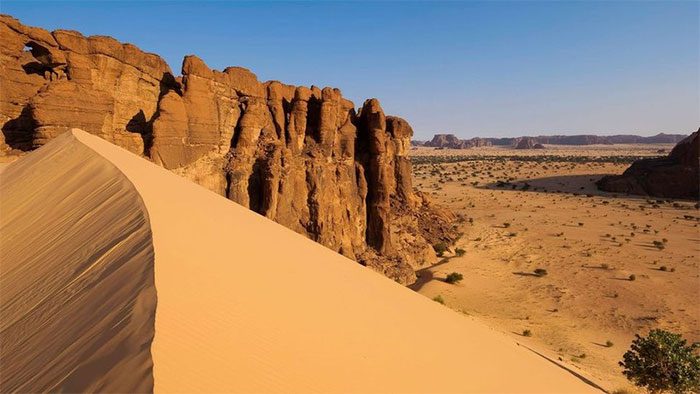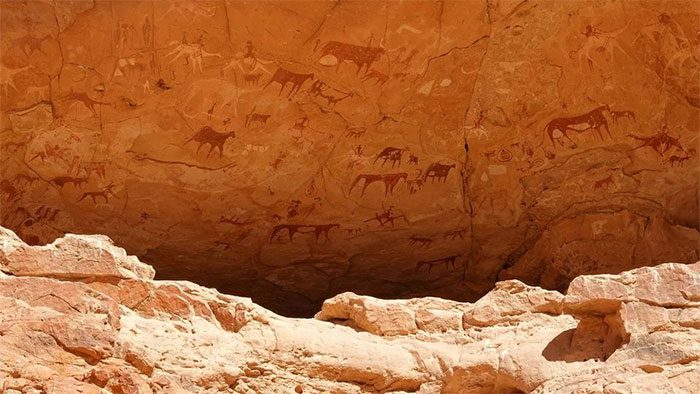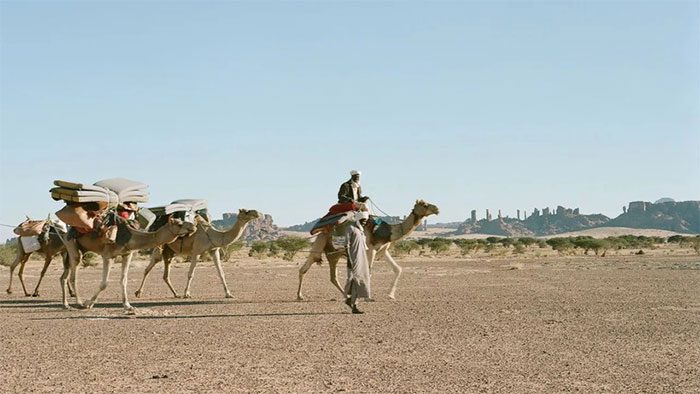The Ennedi Massif is located in the northeastern part of Chad (a country in Central Africa), covering an area of approximately 60,000 km2 with its highest peak reaching 1,450 meters above sea level.
The Ennedi Massif plateau lies deep within the Sahara Desert in Chad, renowned for its majestic and bizarre rock formations, vast sea of sand, and “the least explored place next to the Moon.” This area is rich in prehistoric human remnants, with an estimated 75% still unexplored.

A view of the Ennedi Massif landscape. (Photo: Kate Eshelby, Bbc.com).
“The Desert Wall”
The Ennedi Massif, located in northeastern Chad, spans approximately 60,000 km2 and has a highest peak of 1,450 meters above sea level. The distance from the capital N’Djamena to the Ennedi Massif is about 1,000 km, with rugged roads that often take around four days to reach.
Chad is not a peaceful country. For decades, it has been engulfed in coups, ethnic conflicts, and wars with Libya. Due to its remote location and the ongoing conflicts, the Ennedi Massif has seen little scientific exploration, with estimates suggesting that 75% of the area remains out of reach for researchers.
Despite the limited resources, the Ennedi Massif has gained global fame due to its nickname “the desert wall.” Its landscape is striking, featuring towering rock formations of various shapes, with no trees due to extreme aridity. From a distance, these rock formations resemble a wall blocking the desert.
Upon closer inspection, the “desert wall” is not continuous. It is believed that wind and rain have played significant roles in shaping and distributing these formations. Over millions of years, they have sculpted the rocks into towers, arches, columns, cliffs, and mountain ranges…
World Cultural Heritage

Rock paintings and engravings at Ennedi Massif depict the life and development of humans in this area. (Photo: Kate Eshelby, Bbc.com).
Over 7,000 years ago, the Ennedi Massif was a vast, lush grassland with an annual rainfall of about 250 mm. However, by the middle of the 6th century BC, rainfall began to decrease. By the 5th century, it had dropped to just 150 mm per year, and by the 3rd century, it was as low as 50 mm per year.
Before becoming a desert, the Ennedi Massif was one of the habitats of prehistoric humans. Archaeological research suggests that they may have appeared here around 8000 BC and then settled densely from around 5000 BC onwards, with various groups engaging in hunting and gathering, pottery making, and a strong affinity for art.
The “desert wall” with its smooth, high surfaces became a favored site for prehistoric artists. They primarily depicted humans and animals based on real-life models, leaving behind paintings and engravings on rock that showcase everyday life, including scenes of people working with livestock, hunting, and playing…
Among the depicted figures, men outnumber women, and domesticated animals are more prevalent than wild ones. As the timeline progresses, the artworks reveal more details about daily activities, showcasing advancements in tools, intellect, and the use of carts and horses, as well as discoveries related to genetic diseases…
“For us, the Ennedi Massif is like an open history book left by our ancestors,” shared Angèle Aloumbe, a staff member at the African Park. Within the Ennedi Massif, there are no houses or roads, and it is almost deserted. “Each time I come here, I feel as if I have traveled back in time, quietly admiring the artistic works on the rocks and moved to tears,” he continued.
A Pristine World

Thanks to its inclusion on the World Heritage list, the Ennedi Massif is gradually attracting tourists. (Photo: Kate Eshelby, Bbc.com).
As Aloumbe stated, the Ennedi Massif is one of the most pristine areas in the world. Due to its deep location within the desert, it is almost out of human sight. “When an Italian archaeologist came here, he found a 7,000-year-old piece of pottery in just half an hour,” tour guide Andrea Bonomo recounted.
In 2001, a 7 million-year-old primate skull named Toumaï was discovered in the western part of the Ennedi Massif. Compared to Lucy in Ethiopia, which is only 3.2 million years old, it is significantly older. In addition to Toumaï, archaeologists have also found fossils of other species, proving that Toumaï is not a unique case. Some have begun to believe that the cradle of humanity may be Chad rather than the Rift Valley in Ethiopia.
Despite the dry heat, the Ennedi Massif remains home to many species of flora and fauna. Due to security issues, road conditions, and conflict, researchers have only confirmed the existence of at least 199 species of migratory birds that rest while flying through. In the pools, gorges, and lakes of the Ennedi Massif, desert crocodiles thrive, known for their short bodies, nicknamed “round crocodiles.”
Using trap cameras, scientists have discovered a population of rare North African ostriches living in the Ennedi Massif. They hope that species once thought to be extinct, such as the scimitar-horned oryx, Sudanese leopard, and Ennedi tiger, are also surviving somewhere in this remote highland.
In 2016, the Ennedi Massif was recognized as a World Heritage site by UNESCO. Since 2018, it has been jointly protected and developed for tourism potential in collaboration with the African Park and the Chadian government. In 2019, 50 km2 of the Ennedi Massif was designated as a cultural and natural reserve by Chad.

















































